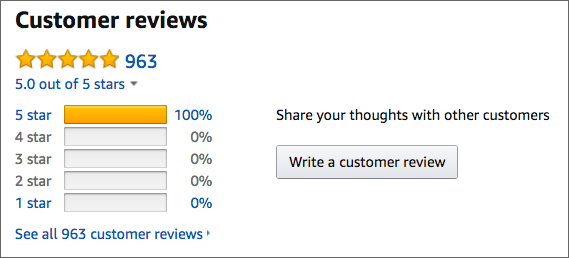Product reviews are the not-so-secret weapon of today’s shoppers. Armed with access to web-based opinions on every connected device, today’s consumers are more empowered than ever before.
It’s time for brands and manufacturers to accept this empowerment as fact. That today’s consumer desires the ability to do independent product research. And that they trust each other—the opinions of virtual strangers—as a key resource for that research.
But the sale teeters on much more than 5 stars.
Perfect Reviews Don’t Equal Perfect Sales
If a brand thinks they need a complete 5 star profile to win customers, they have a thing or two to learn.
In fact, a Deloitte survey published by the Wall Street Journal indicates that “purchase likelihood” is highest when reviews are between 4.2 and 4.5 stars.
Sweeping positive reviews don’t drive the sale of a product for two primary reasons:
 A perfect review score can be an indication of fake or incentivized reviews, and eliminates the shopper’s ability to balance negative opinions with positive ones.
A perfect review score can be an indication of fake or incentivized reviews, and eliminates the shopper’s ability to balance negative opinions with positive ones.
1. Too many positives are a red flag for authenticity. In the example above, where the product has 100% 5 star reviews, one of the only critical reviews was a 1 star that stated “I dislike this product because it is clear the ratings are extremely fake.” Consumers trust reviews and they rely on them heavily (statistics vary between 82% and 90% trust rating). But when it comes to falsified, incentivized, or “fake” reviews, they’re over it. They tend to not even bother with the all-5-star products, because it’s an indicator the data isn’t authentic or trustworthy.
2. Shoppers want to see the bad with the good. 77% of Americans try to read an equal number of positive and negative reviews. This provides a balance of opinion. The bad opinions help them make a decision based on their own unique needs and use cases. They ask themselves whether that negative aspect is a deal breaker for how they plan to use the product.
Strive for Improvement, Not Perfection
Channel Signal CEO Paul Kirwin likes to say that “product reviews are akin to a marathon. You always want to be improving your time, but perfection will never be reached.”
How is this achieved with product reviews?
- Measure – brands should partner with a company that helps them aggregate product reviews and measure them with cutting edge analytics tools. This can help brands eliminate blind spots and get a clear picture of performance.
- Engage – when a negative review is received, the brand can follow these rules for responding to negative reviews. The expectation here should not be to change that negative review, but to make the brand part of the conversation for future shoppers who will read it.
- Improve – using the measurement tools, once constructive feedback becomes a trend, brands should fix the problem or issue. This will ensure the reduction of future negative reviews and therefore a more favorable ROI for those products.
- Leverage – when positive product trends are uncovered, brands should leverage those aspects and products in sales messaging and marketing materials. Similarly, trends from negative reviews about the competition can be used as leverage for a brand’s own products.
In summary, the product search may begin with reviews, but it certainly doesn’t end at 5 stars. The sweet spot for purchase likelihood is between 4.2 and 4.5 stars because they reflect authentic reviews where a consumer can do their own balanced research to make a purchasing decision. Rather than taking pains to achieve perfection, brands should strive to understand and improve based on the post-purchase customer experience.
See how Stanley PMI uses product reviews to hone in on areas for product improvement. Read the case study.

